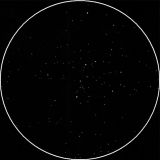
| MESSIER 6 |
|---|
RA: |
17h 40m 18s |
|
DEC: |
-32° 15' 00'' |
|
Type: |
Open cluster |
|
NGC: |
6405 |
|
Magnitude: |
4.20 |
|
Surface brightness : |
||
Apparent dimensions : |
20'x20' |
|
Distance: |
1,300 ly |
|
The Butterfly Cluster (also known as M6 or NGC 6405) is an open cluster in the constellation of Scorpius. It is visually the closest Messier object (in angular distance) to the center of the galaxy in Sagittarius. Most of the bright stars in this 100 million year old cluster are hot, blue B type stars but the brightest cluster member is a K type orange giant star. This star, known as BM Scorpii, is classed as a semiregular variable star, its brightness varying from magnitude +5.5 to magnitude +7.0. In color photographs of the Butterfly Cluster this orange star contrasts sharply with its blue neighbours in the cluster. Estimates of the cluster's distance have varied over the years with a mean value of around 1,600 light years, giving it a spatial dimension of some 12 light years. Modern measurements show its total visual brightness to be magnitude 4.2. Burnham proposed that Ptolemy may have seen the butterfly cluster with the naked eye while observing its neighbor Ptolemy's Cluster (M7). Giovanni Battista Hodierna is the first astronomer to explicity record the butterfly cluster, before 1654. Charles Messier cataloged it in 1764. It was not till the 20th century that star counts, distance, and other properties were measured. |
||
VEDRAN VRHOVAC© 2006.-2007. |
